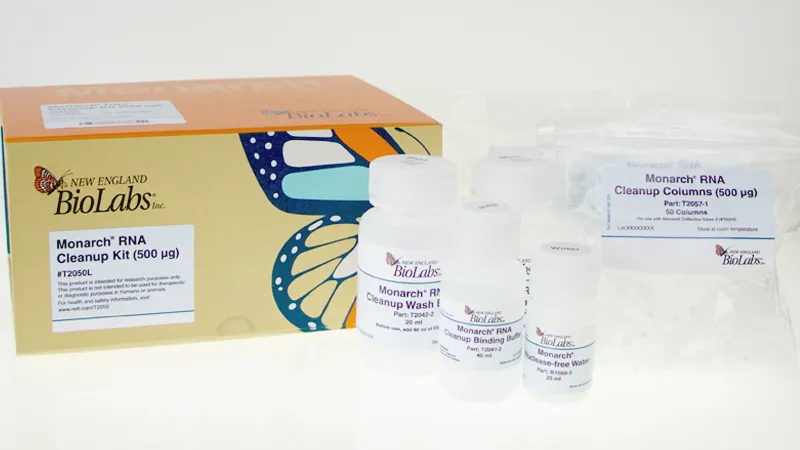Monarch® Spin Columns S2A and Tubes
Product information| Code | Name | Size | Quantity | Price | |
|---|---|---|---|---|---|
T2047L |
Monarch Spin Columns S2A and Tubes |
100 preps | - | Ordering currently unavailable |
Monarch® Spin Columns S2A and Tubes
Effective September 24, 2024, product name modified to Monarch Spin Columns S2A and Tubes.
Product Introduction
- Monarch spin columns and collection tubes designed for nucleic acid purification
- Minimal to no buffer retention/risk of carry-over contamination
- Made with less plastic than conventional columns from leading suppliers
| Catalog # | Size | Concentration |
|---|---|---|
| T2047L | 100 columns |
- Product Information
- Protocols, Manuals & Usage
- FAQs & Troubleshooting
- Citations & Technical Literature
- Quality, Safety & Legal
- Other Products You May Be Interested In
Product Information
Description
The Monarch Spin Columns S2A and Tubes can be used to purify nucleic acid. The columns are designed without the use of a retaining ring, helping to ensure no buffer retention and no carryover of contaminants. Nucleic acid can be eluted in and is ready for use in a variety of downstream applications including RT-PCR, RNA Library Prep for NGS and transfection.
Properties:
|
Also included as a component in: |
T2040 Monarch Spin RNA Cleanup Kit (50 μg) |
|
Product format: |
Spin columns and collection tubes for nucleic acid purification |
|
Technology and purification format: |
Silica membrane-based purification technology |
|
Provided as: |
100 columns and 100 collection tubes |
|
Suitable for: |
Nucleic acid binding and elution |
- This product is related to the following categories:
- RNA Cleanup,
- RNA Extraction and Purification,
- Nucleic Acid Purification,
Reagents Supplied
Reagents Supplied
The following reagents are supplied with this product:
| NEB # | Component Name | Component # | Stored at (°C) | Amount | Concentration | |||||||||||||||||||
|---|---|---|---|---|---|---|---|---|---|---|---|---|---|---|---|---|---|---|---|---|---|---|---|---|
| ||||||||||||||||||||||||
Properties & Usage
Protocols, Manuals & Usage
Protocols
Usage & Guidelines
Application Notes
FAQs & Troubleshooting
FAQs
- I notice that I'm applying force to fit the column into a collection tube. Should I be doing this? What collection tubes are compatible with columns?
- Can the Monarch Spin RNA Cleanup Kits be used for RNA extraction?
- What factors affect my (A260/A230) when using the Monarch Spin RNA Cleanup Kits?
- Can I purchase Monarch® buffers and columns separately?
- I see some silica residue in my Monarch column. Is this a problem?
Troubleshooting
Citations & Technical Literature
Citations
Additional Citations
Quality, Safety & Legal
Quality Assurance Statement
Quality Control tests are performed on each new lot of NEB product to meet the specifications designated for it. Specifications and individual lot data from the tests that are performed for this particular product can be found and downloaded on the Product Specification Sheet, Certificate of Analysis, data card or product manual. Further information regarding NEB product quality can be found here.Specification Change Notifications
Effective September 24, 2024, product name modified to Monarch Spin Columns S2A.
Specifications
The Specification sheet is a document that includes the storage temperature, shelf life and the specifications designated for the product. The following file naming structure is used to name these document files: [Product Number]_[Size]_[Version]Certificate Of Analysis
The Certificate of Analysis (COA) is a signed document that includes the storage temperature, expiration date and quality controls for an individual lot. The following file naming structure is used to name these document files: [Product Number]_[Size]_[Version]_[Lot Number]- T2047L_v1_0011806
- T2047L_v1_10023557
- T2047L_v1_10041696
- T2047L_v1_10059918
- T2047L_v1_10068605
- T2047L_v2_10118164
- T2047L_v2_10126371
- T2047L_v3_10163953
- T2047L_v3_10197189
- T2047L_v3_10237494
- T2047L_v4_10255240
- T2047L_v4_10264025
- T2047L_v4_10273734
- T2047L_v4_10274447
- T2047L_v4_10283746
- T2047L_v4_10289089
- T2047L_v4_10308809
- T2047L_v4_10308809
Legal and Disclaimers
Products and content are covered by one or more patents, trademarks and/or copyrights owned or controlled by New England Biolabs, Inc (NEB). The use of trademark symbols does not necessarily indicate that the name is trademarked in the country where it is being read; it indicates where the content was originally developed. The use of this product may require the buyer to obtain additional third-party intellectual property rights for certain applications. For more information, please email busdev@neb.com.This product is intended for research purposes only. This product is not intended to be used for therapeutic or diagnostic purposes in humans or animals.
New England Biolabs (NEB) is committed to practicing ethical science – we believe it is our job as researchers to ask the important questions that when answered will help preserve our quality of life and the world that we live in. However, this research should always be done in safe and ethical manner. Learn more.
The supporting documents available for this product can be downloaded below.





